Boards
아래에 있는 라세티 프리미어 사고사진과 비교해 보면 좋을 것 같아서 가져왔습니다.
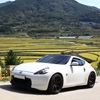
포르테의 경우 라프에 비해 후드 길이도 짧고 필러도 상대적으로 휠하우스 중심쪽에 가까워서
라프에 비해 전해지는 충격량에 차이가 좀 있지않나 생각되네요.

옛날 캐피탈에서 느낄 수 있었던 그 유연한 철판들의 느낌이..-_-;;
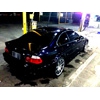
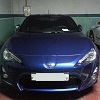

Fender에서 A 필러로 이어지는 부분이 그렇게 차이가 나 보입니까?
포르테는 충격흡수를 엔진룸에서 끝내지 못하고 전면 유리 아래의 격벽까지 파괴된 것일 뿐, 펜더가 A필러를 찌그러뜨릴 강성도 없고 그런 역할도 부여되지 않습니다.

현대자동차를 좋아하시는 분들은 좀 우울하셔도 인정할껀 인정해야 현대차가 더 좋아지겠지요...
저는 현대차를 싫어하기때문에...당연한 결과라고 생각하고 있었습니다...
계속 지금처럼 하다가는 도태되겠지요...
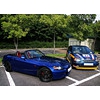
싫어하시는 현대 자동차의 i30같은 경우는 라세티 프리미어보다는 낮은 점수를 받았지만 정량적으로 아주 높은 점수를 받았습니다. 현대 자동차를 싫어하시는데 이건 어떻게 된 것인지요? 그냥 예외인가요? 객관적인 사실을 인정하자고 얘기하시면서 동시에 아주 주관적인 얘기를 하시니 헷갈립니다. 라세티가 현기차뿐만이아닌 다른 동급(혹은 모든)의 차량들에 비해 튼튼하고 훌륭한 것은 말씀하신대로 객관적인 사실입니다. 그런데 그 사실을 폄하하고 무조건 포르테가 좋다고 라세티의 모자란 점을 찾아 까는 것과 무조건 현기차가 싫다고 까는 것에는 차이가 없어보입니다.
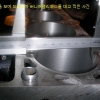
동영상 끝에 나오는 별표는 뭔지 궁금합니다.^^
아시는분 코멘트 좀 부탁드립니다.
라프는 5개중 3개, 포르테는 5개중 5개인데요... 설명 좀 부탁드립니다.^^
(더미의 상해도 인지?)

그런것 같기도 하네요..ㅋㅋ 제목 밑에 딱 버티고 있으니, 이게 뭔가 했습니다.
(라프를 보니.. 왜 지금까지 GM이 이런 차를 못 만들었는지..궁금해 지기도 합니다.^^ 몇몇 브랜드 빼고는 안전도가 썩 좋지는 않았던 것 같은데... 암튼~ 조금 작아서 와이프가 딱 좋아하는 사이즈인데..^^)
아참, 아래 내용을 보니..
포르테도 사이드 임팩트 테스트 점수는 좋네요.^^ Offset이 좀 안타깝네요~~ 나온지 얼마 안되었으니, 빨리 보완해서 내어 놓는게 좋을 것 같기도 하구요..쉽진 않겠지만.^^
참고로 원문 퍼 왔습니다. (출처는 www.landtransport.govt.nz )
잠깐 보면서.. 눈에 띄는 스코어 등은...빨간색이나... 줄을 조금 쳐 뒀습니다.
1. 라세티 프리미어 (Front + side + head airbag 포함, 총점 별 5개, 보행자 상해도 테스트는 2009년 중 예정)
ANCAP crash test results
Holden Cruze | 2009 on
Front+side+head airbags
Occupant protection score: 35.04 out of 37
Model history and safety features
The tested model of Holden Cruze was introduced in Australia during May 2009.
Dual front airbags, side airbags with chest and pelvis protection and head-protecting side curtains are standard equipment. Antilock brakes (ABS), electronic brake distribution (EBD), emergency brake assist and electronic stability control (ESC) are also standard. Advanced seat belt reminders are fitted to both front seats.
The front seat belt buckles are mounted on the seats and the upper anchorages are adjustable. These features improve the fit of the seat belt. Dual pretensioners are fitted to the front seat belts to reduce slack in the event of a crash. A three point seat belt is fitted to the centre rear seat. This provides better protection than a two point (lap) seat belt.
Occupant protection: 




The Cruze scored 15.04 out of 16 in the offset crash test. The passenger compartment held its shape very well. There was a slight risk of serious chest injury for the driver and passenger.
The vehicle scored 16 out of 16 in the side impact crash test and a further two points in the optional pole test.

Frontal offset crash test
Body region scores out of 4 points each: Head/neck 4 pts, chest 3.13 pts, upper legs 4 pts, lower legs 3.91 pts.
The passenger compartment held its shape very well in the offset crash test. The brake pedal moved rearwards by 19 mm. The accelerator pedal moved upwards 6 mm. The steering wheel hub moved 66mm forward, 18mm downward and 5 mm sideways. The front (“A”) pillar moved 4 mm rearwards. All doors remained closed during the crash. After the crash all doors could be opened with normal effort.
The airbag cushioned the head of the driver and contact was stable. There were no driver or passenger knee contacts. The passenger's head was cushioned by the airbag and contact was stable.
Side impact crash test
Body region scores out of 4 points each: Head 4 pts, chest 4 pts, abdomen 4 pts, pelvis 4 pts.
The vehicle was eligible for an optional pole impact test, since it had head-protecting side airbags and it was within reach of a 5 star rating. The manufacturer decided to go ahead with the pole test and the vehicle earned a further two points.
Injury measurements
| Body region | Offset crash test at 64 km/h (v4.1) |
Side impact crash test at 50 km/h (v4.1) | ||
|---|---|---|---|---|
| Driver | Passenger | Driver | ||
| Head HIC | 399 | 482 | 48 | |
| Acceleration (g for 3ms) | 44.9 | 55.5 | 23.8 | |
| Neck - Shear (kN) | 1.01 | 0.84 | - | |
| - Tension (kN) | 0.90 | 0.74 | - | |
| - Extension (Nm) | 7.1 | 16.6 | - | |
| Chest Accln (g for 3ms) | 41.2 | 36.9 | - | |
| Compression (mm) | 28.10 | 24.70 | 17.30 | |
| Viscous criterion (m/s) | 0.10 | 0.06 | 0.08 | |
| Abdomen - Force (kN) | - | - | 0.498 | |
| Pelvis - Force (kN) | - | - | 1.570 | |
| Upper legs - Force (kN) | Left | 0.32 | 0.11 | |
| Right | 0.15 | 0.09 | ||
| Knee displ (mm) | Left | 0.83 | 0.67 | |
| Right | 0.24 | 1.61 | ||
| Lower legs - Force (kN) | Left | 1.27 | 0.15 | |
| Right | 1.29 | 0.10 | ||
| Index (Upper/Low) | Left | 0.30/0.22 | 0.32/0.42 | |
| Right | 0.28/0.15 | 0.41/0.13 | ||
Bonus points (maximum 5)
Pole test: 2 pts
Seat belt reminders: 2 (see table below for details)
Modifiers - deductions from offset test scores
| Head | No deduction | |
| Chest | No deduction | |
| Upper leg | Variable & conc. loading | No deduction |
| Lower leg | No deduction | |
| Foot score | Score 4 points |
Note: Steering column and pedal movements are measured relative to the driver's seat.
Modifiers - deductions from side impact test scores
| Chest | No deduction |
Safety features
These specifications are subject to change. Please check with manufacturer for the latest specifications.
| Driver airbag | S |
| Passenger front airbag | S |
| Side airbags, front seats - chest protection | S |
| Side airbags, front seats - head protection | S |
| Side airbags, rear seats - head protection | S |
| Driver knee airbag | X |
| Seat belt pretensioners (Front/rear outboard) | S/- |
| Antilock (ABS) brakes / Electronic brake distribution / Brake Assist | S/S/S |
| Electronic stability control (ESC, VSC, DSC, ESP, VSA) | S# |
| 3 point centre rear seat belt | S |
| Active head restraints - front seats | X |
| Intelligent seat belt reminder - driver | S |
| Intelligent seat belt reminder - front passenger | S |
| Rear seat belt status indicator | X |
Key:
S = standard on all variants
O = optional on base variant. May be standard on higher variants
V = not available on base variant but standard or optional on higher variants
X = not available on any variant
# = ESC required by ANCAP for 5 star rating from 2008.
Pedestrian protection rating: Pending
Pedestrian protection tests for the Cruze are planned later in 2009.
2. 기타 포르테 (front + side+ head airbag 포함, 총점 별4개, 보행자 별2개)
ANCAP crash test results
Kia Cerato | 2009 on
Front+side+head airbags airbags
Occupant protection score: 26.63 out of 37
Model history and safety features
The tested model of Kia Cerato was introduced in Australia early in 2009.
Dual front airbags, side airbags and head-protecting side curtains are standard equipment. Antilock brakes (ABS), electronic brake distribution (EBD) with Emergency Brake Assist is also standard. Electronic Stability Control (ESC) is standard in New Zealand and on the SLi variant in Australia. ESC is optional on the S variant. An advanced seat belt reminder is fitted to the driver seat.
The front seat belt buckles are mounted on the seats and the upper anchorages are adjustable. These features improve the fit of the seat belt. Pretensioners are fitted to the front seat belts to reduce slack in the event of a crash. A three point seat belt is fitted to the centre rear seat. This provides better protection than a two point (lap) seat belt.
Occupant protection: 



The Cerato scored 9.63 out of 16 in the offset crash test. The passenger compartment held its shape well. There was a moderate risk of serious leg injury was for the driver.
The vehicle scored 16 out of 16 in the side impact crash test.

Frontal offset crash test
Body region scores out of 4 points each: Head/neck 4 pts, chest 3.55 pts, upper legs 0.39 pts, lower legs 1.69 pts.
The passenger compartment held its shape well in the offset crash test. The brake pedal moved rearwards by 124 and upwards 20 mm. The steering wheel hub moved 56 mm rearward, 1 mm upward and 13 mm sideways. The front ("A") pillar moved 42 mm rearwards. All doors remained closed during the crash. After the crash the driver door could be opened with high manual effort.
The airbag cushioned the head of the driver and contact was stable. Steering column components were a potential source of injury for the driver's knees. A production change introduced after the crash test has improved knee protection is this area but some concerns remain. The passenger's head was cushioned by the airbag.
Side impact crash test
Body region scores out of 4 points each: Head 4 pts, chest 4 pts, abdomen 4 pts, pelvis 4 pts.
Although side curtain are fitted the vehicle was not eligible for a Pole Impact Test since it was not within reach of a 5 star rating. This test can earn eligible vehicles an extra two points.
Injury measurements
| Body region | Offset crash test at 64 km/h (v4.1) |
Side impact crash test at 50 km/h (v4.1) | ||
|---|---|---|---|---|
| Driver | Passenger | Driver | ||
| Head HIC | 51 | 37 | 75 | |
| Acceleration (g for 3ms) | 415.0 | 228.0 | 28.9 | |
| Neck - Shear (kN) | 0.37 | 0.58 | - | |
| - Tension (kN) | 1.52 | 0.93 | - | |
| - Extension (Nm) | 10.0 | 19.2 | - | |
| Chest Accln (g for 3ms) | 46.600 | 32.900 | - | |
| Compression (mm) | 25.16 | 24.80 | 20.50 | |
| Viscous criterion (m/s) | 0.06 | 0.08 | 0.12 | |
| Abdomen - Force (kN) | - | - | 0.816 | |
| Pelvis - Force (kN) | - | - | 2.250 | |
| Upper legs - Force (kN) | Left | 0.67 | 0.33 | |
| Right | 5.92 | 2.44 | ||
| Knee displ (mm) | Left | 4.02 | 0.53 | |
| Right | 5.37 | 1.74 | ||
| Lower legs - Force (kN) | Left | 2.74 | 1.98 | |
| Right | 1.95 | 2.30 | ||
| Index (Upper/Low) | Left | 0.25/0.31 | 0.34/0.33 | |
| Right | 0.49/0.92 | 0.36/0.25 | ||
Bonus points (maximum 5)
Pole test: Not eligible due to low offset test score
Seat belt reminders: 1 (see table below for details)
Modifiers - deductions from offset test scores
| Head | No deduction | |
| Chest | No deduction | |
| Upper leg | Variable & conc. loading | 2 pt deduction* Right 1 pt deduction Left |
| Lower leg | No deduction | |
| Foot score | Pedal rearward | Score 3.02 points |
Note: Steering column and pedal movements are measured relative to the driver's seat.
* 0.5 point deduction with improved design of steering column but star rating is unchanged.
Modifiers - deductions from side impact test scores
| Chest | No deduction |
Safety features
These specifications are subject to change. Please check with manufacturer for the latest specifications.
| Driver airbag | S |
| Passenger front airbag | S |
| Side airbags, front seats - chest protection | S |
| Side airbags, front seats - head protection | S |
| Side airbags, rear seats - head protection | S |
| Driver knee airbag | X |
| Seat belt pretensioners (Front/rear outboard) | S/X |
| Antilock (ABS) brakes / Electronic brake distribution / Brake Assist | S/S/S |
| Electronic stability control (ESC, VSC, DSC, ESP, VSA) | 0# (S NZ) |
| 3 point centre rear seat belt | S |
| Active head restraints - front seats | S |
| Intelligent seat belt reminder - driver | S |
| Intelligent seat belt reminder - front passenger | X |
| Rear seat belt status indicator | X |
Key:
S = standard on all variants
O = optional on base variant. May be standard on higher variants
V = not available on base variant but standard or optional on higher variants
X = not available on any variant
# = ESC required by ANCAP for 5 star rating from 2008.
Pedestrian protection rating: 

The majority of the child head test area scored well. More work is required to improve the adult head test area. Improvements need to be made to both leg contact areas.
| Child head impacts | 8 |
| Adult head impacts | 2 |
| Upper leg impacts | Zero |
| Lower leg impacts | Zero |
| Total (out of 36) | 10 |


디자인도 전세계 준중형 급중 수준급이고~ 안전 성능도 좋구~
라프를 통해서... 대우 개발진들이 내공을 많이 쌓았을텐데~
향후 모든 차량이 이 이상의 안전도로 나오면 좋겠습니다.^^
좋은차는 나왔는데... 막상 와이프 차는 메인터넌스를 너무 심하게 해놔서..
5년이상은 오일과 미션만 염두해 두면 되는 상태라... 아쉽네요. (돈 굳었는데...아쉬워 말아야 하는 건데..ㅋㅋ )
과거 SM5가 중형 시장에 몰고왔던 그 바람처럼~
라프도 준중형 시장에 확실하게 인상 심어주길 바래 봅니다.^^

1600cc수동 기준
라프 1290kg
i30 1227kg
포르테 1162kg

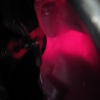
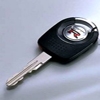
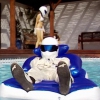
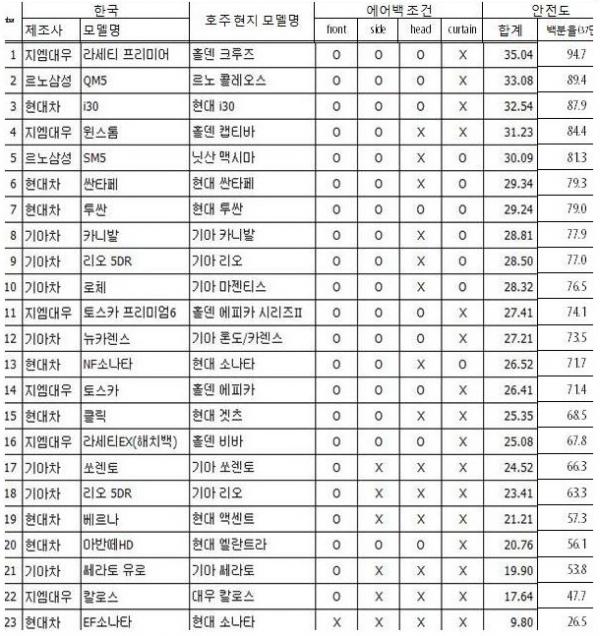
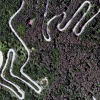

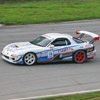


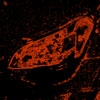







궁금한게 있는데 현대/기아차들의 옵셋충돌 장면들을 보면 왜 하나같이 뒷바퀴가 한 50센티쯤은 공중부양하는 걸까요?